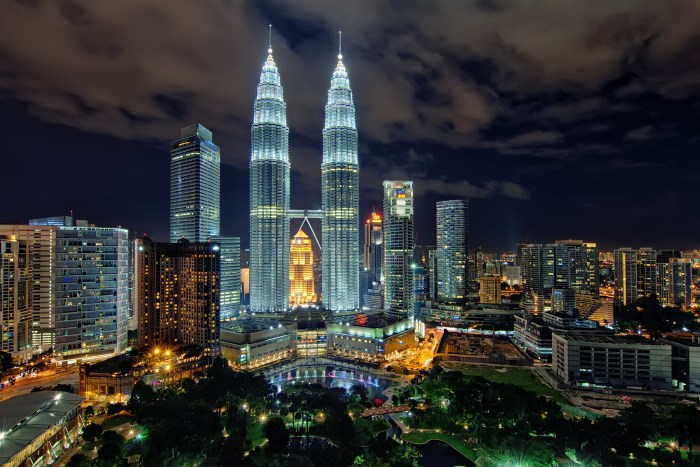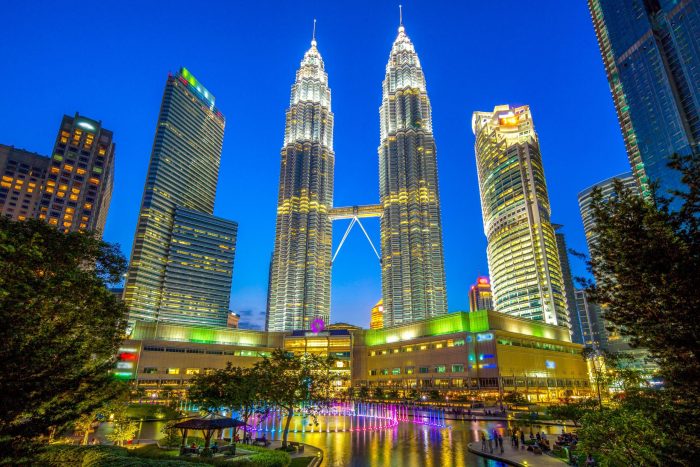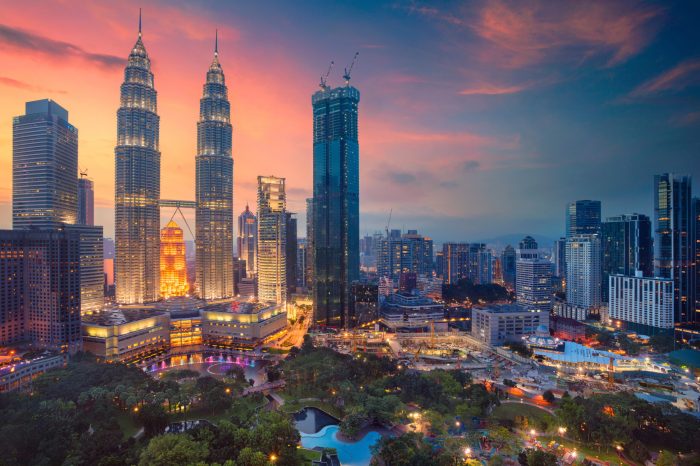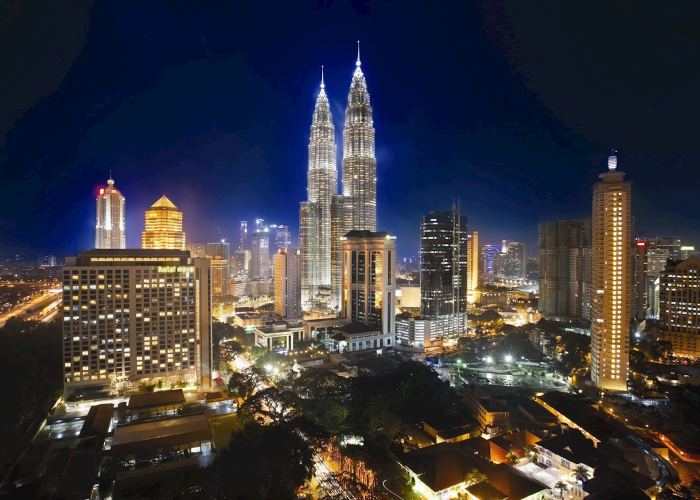Kuala Lumpur, the bustling capital of Malaysia, is a vibrant metropolis that seamlessly blends its rich historical heritage with modern architectural marvels. From its humble beginnings as a tin mining settlement to its present-day status as a regional economic powerhouse, Kuala Lumpur has emerged as a captivating destination that offers a captivating blend of tradition and innovation.
The city’s diverse ethnic and cultural groups have left an indelible mark on its identity, creating a vibrant tapestry of languages, religions, and traditions. Kuala Lumpur is a melting pot of flavors, with a culinary scene that tantalizes taste buds with a delectable array of cuisines, from traditional Malaysian dishes to international delights.
Historical Significance

Kuala Lumpur’s origins can be traced back to 1857, when Chinese miners settled at the confluence of the Klang and Gombak rivers in search of tin. The settlement grew rapidly, and in 1880 it was declared the capital of the newly formed Federated Malay States.
The city’s colonial past has left a lasting legacy on its architecture and culture. Many of the city’s most iconic buildings, such as the Sultan Abdul Samad Building and the Kuala Lumpur Railway Station, were built during the British colonial period.
The city’s diverse population also reflects its colonial history, with Malays, Chinese, Indians, and Europeans all calling Kuala Lumpur home.
Kuala Lumpur, Malaysia’s vibrant capital, boasts a captivating blend of modern skyscrapers and traditional landmarks. Just a short flight away lies Yogyakarta, Indonesia, home to the renowned the alana yogyakarta hotel & convention center. This luxurious hotel offers world-class amenities and elegant accommodations, making it an ideal choice for business travelers and leisure seekers alike.
Upon returning to Kuala Lumpur, immerse yourself once more in the city’s vibrant atmosphere, exploring its bustling markets and iconic landmarks.
Historical Landmarks
- Sultan Abdul Samad Building:This iconic building is one of the most recognizable landmarks in Kuala Lumpur. It was built in 1897 and served as the headquarters of the British colonial government. Today, it houses the Ministry of Information, Communications, and Culture.
- Kuala Lumpur Railway Station:This grand railway station was built in 1910 and is one of the busiest in Southeast Asia. It is a beautiful example of Moorish architecture and is a popular tourist destination.
- Masjid Jamek:This mosque is the oldest in Kuala Lumpur and was built in 1909. It is a beautiful example of Indo-Saracenic architecture and is a popular tourist destination.
Cultural Diversity: Kuala Lumpur

Kuala Lumpur is a vibrant tapestry of cultures, a melting pot of ethnicities and traditions. The city’s rich history as a trading hub has attracted people from all over the world, resulting in a diverse population that contributes to its unique identity.
Languages
Kuala Lumpur is a multilingual city where various languages coexist harmoniously. The official language is Bahasa Melayu, but English is widely spoken as a second language. Other languages commonly used include Mandarin, Tamil, and various Chinese dialects, reflecting the city’s diverse heritage.
Religions
Kuala Lumpur is home to a diverse array of religions, each contributing to the city’s spiritual and cultural landscape. Islam is the predominant religion, followed by Buddhism, Christianity, Hinduism, and Taoism. The city boasts numerous mosques, temples, churches, and shrines, showcasing the harmonious coexistence of different faiths.
Traditions
The cultural diversity of Kuala Lumpur is reflected in its traditions and customs. The city celebrates a blend of Malay, Chinese, Indian, and Western influences. Traditional Malay weddings, vibrant Chinese New Year festivities, colorful Deepavali celebrations, and festive Christmas markets add to the city’s vibrant cultural calendar.
Cultural Festivals
Kuala Lumpur hosts a wide range of cultural festivals that showcase the city’s diverse heritage. The annual Thaipusam festival attracts thousands of devotees, who engage in colorful processions and rituals. The George Town Festival celebrates the city’s rich cultural history through art, music, and cultural performances.
The KL International Arts Festival brings together renowned artists from around the world, showcasing a diverse range of performances.
3. Economic Hub
Kuala Lumpur serves as a prominent economic powerhouse in Southeast Asia. Its strategic location, coupled with a highly skilled workforce and government initiatives, has transformed the city into a vibrant economic hub.
The city’s economy is primarily driven by:
- Financial services
- Tourism
- Manufacturing
- Real estate
Kuala Lumpur is home to several major corporations and financial institutions, including:
- Petronas
- Maybank
- CIMB Group
- Tenaga Nasional Berhad
These companies play a crucial role in driving economic growth and attracting foreign investment.
4. Modern Architecture

Kuala Lumpur’s skyline is a testament to its rapid modernization, boasting an impressive array of iconic skyscrapers and modern architectural marvels. These structures embody innovative design and cutting-edge architectural styles, reflecting the city’s ambition and global aspirations.
Notable Buildings
Among the most recognizable landmarks in Kuala Lumpur are the following buildings, each showcasing a distinct architectural style and design:
| Building | Image | Description |
|---|---|---|
| Petronas Towers | [Insert image here] | Twin skyscrapers designed by Argentine-American architect Cesar Pelli, featuring a distinctive Islamic-inspired design with sky bridges connecting the two towers. |
| KL Tower | [Insert image here] | A telecommunications tower designed by Malaysian architect Hijjas Kasturi, resembling a giant needle with a futuristic observation deck offering panoramic city views. |
| Suria KLCC | [Insert image here] | A luxury shopping mall designed by American architect James Adams, featuring a striking glass roof and a water fountain show in its central atrium. |
| National Museum of Malaysia | [Insert image here] | A neo-Moorish building designed by British architect Arthur Benison Hubback, housing Malaysia’s largest collection of historical artifacts and cultural exhibits. |
| Menara Kuala Lumpur | [Insert image here] | A communications tower designed by Malaysian architect Hisham Albakri, inspired by Islamic architecture and offering a revolving restaurant with stunning city views. |
Culinary Delights
Kuala Lumpur is a gastronomic paradise, boasting a vibrant culinary scene that tantalizes taste buds from around the globe. The city’s diverse culinary landscape offers an eclectic mix of traditional Malaysian dishes and international flavors, creating a harmonious symphony of tastes and aromas.
Recommended Restaurants and Street Food Stalls
For an authentic Malaysian dining experience, visit Restoran Nasi Kandar Pelita, renowned for its aromatic nasi kandar, a fragrant rice dish served with an array of curries and side dishes. For a taste of modern Malaysian cuisine, Dewakanoffers an innovative menu that celebrates local ingredients with contemporary culinary techniques.
To sample the city’s street food delights, head to Jalan Alor, a bustling street lined with stalls offering a tantalizing array of grilled satay, flavorful laksa, and sweet cendol.
Transportation
Kuala Lumpur boasts an extensive and efficient transportation network that caters to the needs of its residents and visitors alike. From a comprehensive public transportation system to a well-developed road network, getting around the city is a breeze.
The public transportation system in Kuala Lumpur is widely regarded as one of the best in Southeast Asia. It comprises an integrated network of trains, buses, and taxis that seamlessly connect different parts of the city. The trains, operated by RapidKL, form the backbone of the public transportation system, with three main lines serving the city center and its suburbs.
Rail Network
- The Kelana Jaya Line (red) runs from Gombak in the north to Putra Heights in the south, passing through the city center.
- The Ampang Line (purple) connects Sentul in the north to Ampang in the east, also passing through the city center.
- The Sri Petaling Line (green) runs from Sentul in the north to Putra Heights in the south, parallel to the Kelana Jaya Line.
The buses in Kuala Lumpur are operated by various companies and provide a comprehensive network of routes covering all parts of the city. The taxis in Kuala Lumpur are metered and widely available, making them a convenient option for getting around the city.
In addition to the public transportation system, Kuala Lumpur also has a well-developed road network. The city is connected to other parts of Malaysia by a network of highways and expressways. The North-South Expressway connects Kuala Lumpur to Penang in the north and Johor Bahru in the south.
The East Coast Expressway connects Kuala Lumpur to Kuantan in the east. The Kuala Lumpur-Karak Highway connects Kuala Lumpur to the Genting Highlands.
Kuala Lumpur, a vibrant metropolis brimming with skyscrapers and cultural landmarks, offers a captivating urban experience. For a taste of coastal charm within the city’s bustling atmosphere, consider venturing to Seminyak Square , a lively open-air mall that evokes the laid-back ambiance of Bali.
Amidst the chic boutiques and delectable dining options, you can soak up the sun and immerse yourself in the tropical allure that complements Kuala Lumpur’s urban tapestry.
Arts and Entertainment
Kuala Lumpur is a vibrant hub for arts and entertainment, boasting a diverse range of cultural offerings. From world-class theaters and museums to cutting-edge art galleries and lively music venues, the city’s cultural landscape is teeming with creativity and expression.
Theaters
Kuala Lumpur is home to several prestigious theaters, including the iconic Petronas Philharmonic Hall, known for its world-renowned acoustics and hosting the Malaysian Philharmonic Orchestra. The Kuala Lumpur Performing Arts Centre (KL PAC) is another renowned venue, showcasing a wide range of productions, from musicals to contemporary dance performances.
Museums, Kuala lumpur
The city is also home to a number of world-class museums, including the National Museum of Malaysia, which houses a vast collection of artifacts and exhibits showcasing the country’s rich history and cultural heritage. The Islamic Arts Museum Malaysia is another must-visit, featuring a stunning collection of Islamic art from around the world.
Art Galleries
Kuala Lumpur’s art scene is thriving, with numerous art galleries showcasing the works of both established and emerging artists. The National Art Gallery is the largest art gallery in Malaysia, featuring a diverse collection of contemporary and traditional Malaysian art.
The Wei-Ling Gallery is another notable venue, known for its exhibitions of contemporary Asian art.
Music Venues
Kuala Lumpur’s music scene is equally vibrant, with a wide range of live music venues catering to all tastes. The Blue Note KL is a renowned jazz club, hosting both local and international musicians. The Live Fact is another popular venue, showcasing a mix of live music, comedy, and theater performances.
Nature and Recreation

Kuala Lumpur offers a refreshing contrast to its urban landscape with its abundance of green spaces and recreational areas. These havens provide a welcome respite from the hustle and bustle of the city, offering opportunities for relaxation, recreation, and connection with nature.
Kuala Lumpur, Malaysia’s vibrant capital, is a bustling metropolis with towering skyscrapers, lush greenery, and a vibrant street food scene. For a taste of Thailand’s lively coastal charm, consider a trip to pattaya. This seaside resort town offers pristine beaches, vibrant nightlife, and a unique blend of traditional Thai culture and modern amenities.
After exploring the allure of pattaya, return to Kuala Lumpur to delve further into its captivating blend of modernity and tradition.
Within the heart of the city, the sprawling Lake Gardens (Taman Tasik Perdana) serve as a tranquil oasis. This 227-acre park boasts lush greenery, a serene lake, and various attractions, including the National Monument, Bird Park, and Orchid Garden. The park’s jogging paths, playgrounds, and picnic areas make it a popular destination for families and fitness enthusiasts alike.
Hiking Trails
For those seeking more adventurous outdoor experiences, Kuala Lumpur offers several hiking trails within easy reach of the city center. Bukit Gasing Forest Reserve, located just south of the city, features a network of well-maintained trails suitable for hikers of all levels.
The trails wind through dense tropical rainforest, offering panoramic views of the surrounding cityscape.
Another popular hiking destination is Bukit Tabur, located about 30 kilometers northeast of Kuala Lumpur. This challenging hike rewards climbers with breathtaking views of the Selangor River Valley and the distant Titiwangsa Mountains.
Nature Reserves
Beyond the city limits, Kuala Lumpur is surrounded by several nature reserves that offer a glimpse into Malaysia’s rich biodiversity. The Bukit Nanas Forest Reserve, a 13-acre patch of rainforest within the city center, is home to a diverse range of flora and fauna.
The reserve’s canopy walkway provides a unique perspective of the rainforest ecosystem.
Further afield, the Kuala Selangor Nature Park, located about 60 kilometers northwest of Kuala Lumpur, is a haven for birdwatchers. The park’s mangrove swamps and coastal forests are home to a wide variety of bird species, including migratory birds from as far away as Siberia.
Ending Remarks

As the sun sets over Kuala Lumpur, casting a warm glow upon its towering skyscrapers and tranquil green spaces, it is evident that this dynamic city has something to offer every traveler. Whether you seek historical exploration, cultural immersion, or simply the thrill of exploring a modern metropolis, Kuala Lumpur beckons with its irresistible charm and promises an unforgettable experience.
Popular Questions
What is the best time to visit Kuala Lumpur?
Kuala Lumpur is a year-round destination, but the best time to visit is during the dry season, from March to October.
Is Kuala Lumpur a safe city?
Kuala Lumpur is generally considered a safe city, but it is always advisable to take precautions and be aware of your surroundings.
What is the official language of Kuala Lumpur?
The official language of Kuala Lumpur is Malay, but English is widely spoken.